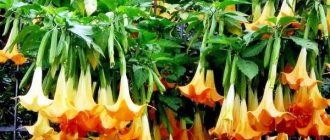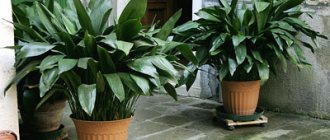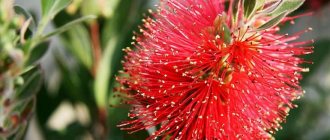Among the unusual and very attractive “green pets” we can confidently include Dracaena Marginata, an exotic plant with healing properties. This flower helps purify the air in the room in which it is located, acting as a natural air conditioner. An additional advantage is its ease of care, which even a beginner can handle.
General description of the plant
Dracaena marginata is a tree from the genus Dracaena of the Asparagus family.
The plant’s homeland is the island of Madagascar, which is why dracaena is often called the Madagascar Dragon Tree, because the word “dracaena” translated from Greek means “female dragon.” In Russia, it became an indoor flower and a favorite of gardeners, but under the name Margarita.
Wild plant specimens reach a height of 3 to 5 m, while domestic ones grow up to 1.5 m.
Visually, the Madagascar tree resembles a palm tree. It has a smooth, tree-like trunk, topped with a cap of foliage. The leaves are green, serrated and narrowly linear. Their length can reach up to 70 cm, and their width ranges from 2 to 4 cm. Some varieties have longitudinal stripes of green, white and even pink on the foliage, which gave rise to another name for the plant - bordered dracaena.
At home, dracaena blooms quite rarely. If this does happen, then the owner has to take the plant out of the room, since the aroma emitted by the flower of the tree is very pungent.
Possible growing difficulties
When caring for Dracaena Marginata at home and replanting the plant, you may encounter some difficulties. The leaves of the flower may begin to fall off, change color, or dry out. Once you figure out the cause of the problem, you can easily solve it. So, if the plant does not develop, most likely it is due to the lack of feeding. The following problems can be listed:
- Leaves fall due to low temperatures or excessive moisture.
- The tips of the plates dry out - the room is cold or dry.
- Leaf rotting is associated with excessive moisture of the plant, as well as insufficient lighting. May be caused by diseases.
- Change in color, fading - the flower does not have enough light.
- Black spots are burns. The plant should be protected from direct sunlight.
- The leaves turn completely black, which means Marginata has problems with the root system. You should do this: remove the flower from the soil, place it in a container containing settled water with the addition of 2 tablets of activated carbon. The plant should be kept in such a liquid for several days, changing the liquid if necessary (it is important to avoid its attenuation). As soon as the roots are restored, they are transplanted into fresh soil.
- Young leaves begin to dry out most often due to the abuse of mineral fertilizers, as well as when growing in one pot for several years without replanting.
Any of these problems will not be difficult to quickly resolve by creating acceptable living conditions for the dracaena and normalizing watering. But not everything is so simple; an exotic flower can also get sick or be affected by pests. They must be fought. There are several diseases to which dracaena marginata is predisposed:
- Phyllocystosis. It manifests itself by the formation of brown spots with a yellow edging that affect the leaf plate. Treatment with fungicides will solve the problem.
- Heterosporosis. Brownish spots appear on the leaves, which gradually increase in size. The drugs Fundazol and Fitosporin-M are used for treatment.
- Alternaria blight. Light brown spots with a black center appear on the plant; the same fungicides are used to combat the disease. Spraying is done three times, at intervals of 10 days, this is the only way to destroy the fungus.
In addition to diseases, Dracaena Marginata can also be attacked by various insect pests, for example, aphids, scale insects, thrips, spider mites; you can get rid of them by spraying the plant with a soapy solution or using special preparations.
These are the main secrets that allow you to care for Dracaena Marginata; they will help make the flower beautiful, lush and pleasing to the eye. There is nothing complicated about this, the main thing is to remember that excessive moisture and direct rays of the sun are destructive for a guest from the tropics, and also protect him from drafts.
The most popular varieties
Dracaena Martinata is one of the few species of Madagascar tree that can be cultivated indoors. The following varieties of this flower are especially popular among gardeners:
- Marginata is a natural species with a reddish-purple border around the edge of the green leaves.
- Bicolor - the variety is characterized by peculiar narrow foliage with beautiful longitudinal stripes of pink color.
- Tricolor - this variety is distinguished by leaves with narrow red and yellow stripes, creating a golden-green coloring effect.
- Colorama - This variety has the lightest foliage with a wide red border.
- Magenta or Magenta - plants of this variety have bright green foliage with crimson edging.
Magical properties of the flower
The edged dracaena is especially popular in China. Residents of the Middle Kingdom consider the exotic tree to be an ideal gift for loved ones and even call it “the bamboo of happiness.” In their opinion, happiness will come to the house where Dracaena Marginata grows.
And the magical properties of the flower are truly remarkable; they are manifested in the following:
- attracting positive energy;
- strengthening friendships and love connections;
- cleansing the energy of thoughts, words and feelings;
- improved health;
- assistance in wound healing;
- treatment of various skin diseases;
- positive effect on the musculoskeletal system;
- significant extension of life;
- improvement of financial situation.
Replanting after purchase
After purchasing a plant from a flower shop, it is important to immediately inspect it in order to decide on the future fate of the tree. If the purchase took place in winter or autumn and the plant is in good condition and has enough land for growth, then replanting can be postponed until spring.
Usually a purchased flower requires replanting because:
- the flower shop may have used unsuitable soil for the plant;
- during the time that the flower spent on the store shelf, the soil could be depleted;
- perhaps the sellers did not adhere to the rules for caring for dracaena;
- the plant may already be cramped in the pot, as evidenced by roots sticking out of the drainage holes.
Even if, by all indications, the purchased flower requires an urgent transplant, it should be done no earlier than two weeks after purchase. This period is necessary for the dracaena so that it can fully adapt to the new conditions of detention.
If the flower was purchased in the spring, when all the plants begin to grow, then it can be replanted after two weeks of adaptation.
For successful transplantation, you need to prepare a suitable pot, good drainage and a new loose substrate.
Preparation
If the tree is in a purchased pot, the day before transplanting it should be thoroughly watered over the sink or bathtub. So that water flows out of the holes made in the bottom of the container. Then the next day it will not be difficult to remove the soil and roots from the pot without damaging them. Place the container in a dish, the excess liquid will drain overnight and the soil will become quite dense. In the case when the vessel is simply small or becomes cramped, you need to water the soil generously.
The following components will be required:
- shells of 3-4 eggs, pre-crushed into crumbs,
- the pot is at least 2 times larger than before,
- several pebbles of expanded clay, so as to cover the bottom of the vessel,
- soil, best purchased, since it is already filled with all the necessary nutrients,
- potassium permanganate, or simply put, potassium permanganate,
- 100 gr. boiled warm water,
- tablespoon.
Home care
At home, caring for Dracaena Marginata is not difficult. In the wild, the tree grows in difficult climatic conditions, and therefore the potted plant has minimal care requirements.
Being a tropical plant, dracaena loves warmth, and therefore the ideal temperature for it should be in the winter from 18 to 22 degrees and in the summer from 25 to 28 degrees. In summer, it is better to take the flower outside.
Both indoors and when placing a plant outdoors, you must ensure that it is not exposed to a draft. Dracaena does not tolerate drafts very well, especially in cold seasons.
Watering a flower should always be moderate. Excess moisture will lead to rapid death of the plant. To avoid stagnation of moisture in the roots, when planting or replanting all varieties of trees, including Dracaena Magenta, a layer of drainage 3-5 cm thick must be placed at the bottom of the pot.
Contact with direct sunlight on the foliage of a plant will lead to its burning or appearance.
Organization of care
Caring for Dracaena Marginata is quite simple and does not require special training or specific knowledge, but certain subtleties must still be observed. First of all, the plant needs to be provided with normal temperature and light conditions, since a dry climate and lack of light can be detrimental to it. The flower is afraid of drafts , this should also be taken into account when choosing a place for planting. However, in general, dracaena does not belong to the category of capricious plants, since in nature it grows in rather difficult climatic conditions and is accustomed to deprivation.
Having purchased a flower, you should place it in a place warmed by the sun, but protect it from direct rays, which can cause burns on the leaves. In summer, you can move the pot to the balcony, but also organize partial shade. Almost any indoor plants can be neighbors, but it is best if there are palm trees, yuccas or ficuses nearby.
Planting and transplanting
For a guest from the tropics, it is very important to choose good soil and a pot. The easiest way to purchase a ready-made soil mixture is in the store; it is called “For dracaenas.” It is advisable to add a small amount of crushed brick to it, which will loosen the soil. The size of the container is selected based on the characteristics of the root system: its width should be approximately 4 cm larger than the girth of the roots.
The first step in caring for Dracaena Marginata Magenta at home is planting the plant. The further growth of the “green pet” will depend on how correctly this was accomplished. They do it like this:
- The pot intended for the flower is washed and doused with boiling water.
- A layer of expanded clay is placed on the bottom, which will act as drainage.
- Soil is poured.
- The plant is carefully removed from the container in which it was purchased; it is advisable to dip the root system in warm water and rinse.
- Holding the flower by the trunk, place it in a new pot and sprinkle it with earth, compacting it.
- Now you need to spray the soil with a spray bottle.
It is very important to replant the plant immediately after purchase, since the soil used in specialized stores may be poor, which will become an obstacle to the normal growth of Marginata. After transplantation, “quarantine” conditions are created for the dracaena - the pot is placed separately from other flowers, fenced off from direct sunlight, providing regular but moderate watering. After 15 days, the plant can be transferred to its permanent “place of residence.”
Methods of watering and fertilizing
The roots of the southern plant do not tolerate excessive moisture, so watering must be careful. Experienced flower growers recommend using a special attachment on the watering can - a diffuser, so as not to blur the earthen lump. In summer, water 1-2 times a week, when the soil becomes dry not only outside, but also to a depth of 2-3 cm; in winter, the frequency is reduced to 1-2 times a month.
In hot weather, water procedures also include spraying the crown with a spray bottle. In order not to prevent oxygen from reaching the roots, it is recommended to carefully loosen the soil after moistening.
In summer it is necessary to feed the flower with complex fertilizer about twice a month; in winter it is necessary to fertilize it no more than once every 30 days. The easiest way is to use a ready-made fertilizer, for example, “Doctor Foley Starter,” which is applied to the leaf blades. However, if the pot is at a temperature lower than +19°C, feeding stops altogether.
Shaping and trimming
The tree-like plant needs to be given a nice and neat shape because the lower leaves die over time, leaving an ugly bare trunk covered with scars. Timely pruning of the top will help create an interesting crown, which will save up to 5 leaves. The remaining top can be used to propagate the flower. A sharp knife is used as a tool. The cut must be sprinkled with crushed charcoal.
If you wish, you can try to stimulate the growth of side shoots; to do this, the cut area is wrapped in polyethylene to retain moisture. In this way, you can get up to 3-4 buds in about 30 days. When shoots form, the film is removed. During the period of growth of lateral buds, moderate watering should be organized. To form a lush top, the pruning procedure is repeated several times.
Pruning Dracaena Marginata
The long bare stems of the plant lose their decorative effect as they grow, and the flower itself grows so much that it begins to require too much space. In this case, experienced gardeners advise pruning Dracaena Marginata .
Timely pruning allows you to:
- limit vertical growth of shoots;
- activate tillering;
- give the flower a more compact shape;
- obtain material for plant propagation.
Dracaena is pruned only in spring. During pruning, the top of the stem of the tree is cut off, after which the cut site is sprinkled with activated or crushed charcoal. To seal thick trunks, it is better to use paraffin or garden wax. After processing, the top of the shoot must be covered with polyethylene.
In the future, additional buds will gradually awaken on the topless stem, from which new shoots will grow.
How to prune Dracaena magrinata and replant the plant?
Having brought a plant home from a flower shop, it is important to examine it and make a decision about the fate of the flower. Transplanting Dracaena marginalata after purchase can be postponed if the plant purchased in winter or autumn is in good condition and has enough soil for growth. Unfortunately, this is not always the case. Excessively wet soil or roots sticking out of the pot are a sure sign that urgent measures are necessary!
But when buying a flower in the spring, when all living things begin to grow, the dracaena can be safely transferred to a new loose substrate after two weeks, having first selected a suitable pot.
Since the plant grows quickly and is tall, it is better to give preference to a stable, heavy pot with a wide base, which will ensure the safety of both the plant and people.
The long bare stems of dracaena lose their decorative effect after a while, and the plant requires too much space. How to prune dracaena marginalata, and when is the best time to do it?
This procedure is one of the necessary measures for caring for Dracaena marginalata at home. It is carried out:
- to limit the vertical growth of shoots;
- to activate tillering;
- to give the flower a more compact shape.
The top of the stem of the dracaena is cut off, and the cut site is treated with crushed charcoal or activated carbon. For large trunks, use candle paraffin or garden wax. The top of the shoot is covered with a bag or film. With further care, additional buds gradually appear on the bare stem, and the formation of new shoots begins. The remaining top also takes root easily and becomes an independent plant.
Pruning, as well as propagation of dracaena, is done in the spring. In addition to apical shoots, to produce new young flowers, they use segments of stems about 10–15 cm long, air layering, as well as children formed at the base of an old specimen of Dracaena marginata, as in the photo.
Rooting is carried out in a mixture of sand and peat with the addition of pieces of charcoal and sphagnum. The best results can be obtained in greenhouse conditions.
It takes no more than 30 days to form a full-fledged root system. Subsequently, young dracaenas are replanted at intervals of 2–3 years, carefully transferring the earthen lump into a pot a couple of centimeters larger than the previous one. To plant a plant, drainage and light, well-aerated soil are required, for example, a ready-made mixture for palm trees and dracaenas containing finely crushed red brick, sand and coal.
Tree propagation
Dracaena is always propagated in the spring. For this purpose, the top of the shoot remaining after pruning, stem cuttings from 10 to 15 cm long, air layering and children that grow at the base of an adult plant are suitable.
Step-by-step description of the dracaena propagation process:
- Use a sharp knife to cut off the top of the plant or cut off part of the stem.
- The fresh cut is dried for one to two days by wrapping it in a paper towel or gauze. It is then treated with a root stimulating agent.
- The prepared cuttings are placed in purified and settled water for a month. During this time, it will produce roots, which will allow the dracaena to be planted in the ground.
It should be noted that some gardeners prefer to plant cuttings in the ground immediately after treatment with a composition that stimulates root formation. In this case, the soil is made up of sand, peat, pieces of charcoal and sphagnum. Plants that take root best are those that are given greenhouse conditions using a glass jar or polyethylene.
In the future, young trees are replanted every 2-3 years.
To do this, a layer of drainage is placed in a pot with a slightly larger diameter than the previous one, on top of which a light, well-aerated soil is placed, for example, a ready-made mixture for palm trees and dracaenas. Then the earthen lump of the plant is carefully transferred there and sprinkled with the remains of the soil.
Flower propagation
There are two ways to propagate a plant - using layering and cuttings. Each method is accessible to beginners and does not require prior preparation. At the same time, the use of layering is considered a more difficult method of propagation, since it is necessary to select a stem of optimal length. The following is the procedure:
- An incision is made on the stem, into which a foreign body, a wedge, should be placed to avoid fusion.
- A bag of soil is attached next to the cut; it should fit snugly to the cut site. For fixation, use wire or thread. The soil should be kept moist, so it will need to be sprayed periodically.
- When roots appear on the shoot, it is completely separated from the mother plant and placed in its own pot.
The cutting method is even simpler: you need to select a powerful stem, cut it into cuttings 5 cm long, each of them should have a pair of buds. An incision is made on the lower part of the cutting; it should be treated with a rooting solution, after which the future plant is placed in the soil to a depth of about 2 cm. To create a greenhouse effect, the container with the cuttings is covered with film or plastic bottles. After this, they are transferred to a dark, warm place for rooting, not forgetting to open the “greenhouse” for watering and ventilation.
Another way to root a cutting is to place it in a container with water, and when the roots appear, transplant it into the ground.
Reproduction is recommended to be done in the first days of summer or the last week of May.











